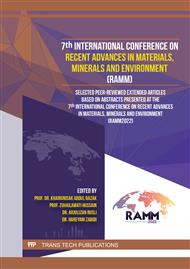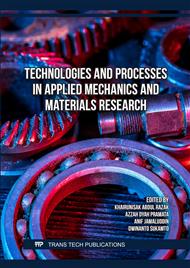[1]
ELTurk, M., et al., Heavy metal contamination in mangrove sediments in Klang estuary, Malaysia: Implication of risk assessment. Estuarine, Coastal and Shelf Science, 2019. 226(6): p.106266.
DOI: 10.1016/j.ecss.2019.106266
Google Scholar
[2]
Sankhla, M.S., et al., Heavy Metals Contamination in Water and Their Hazardous Effect on Human Health. International Journal of Current Microbiology and Applied Sciences 2016. 5(9): pp.759-766.
DOI: 10.20546/ijcmas.2016.510.082
Google Scholar
[3]
A. L. Wani, A. Anjum, and U. JawedAhmad, Lead toxicity: A review. Interdisciplinary Toxicology, 2015. 8(2): pp.55-64.
Google Scholar
[4]
Rice, K.M., et al., Environmental Mercury and Its Toxic Effects. J Prev Med Public Health, 2014. 47.
Google Scholar
[5]
Genchi, G., et al., The effects of cadmium toxicity. International Journal of Environmental Research and Public Health, 2020. 17(11): pp.1-24.
Google Scholar
[6]
Mandal, P., An insight of environmental contamination of arsenic on animal health. Emerging Contaminants, 2017. 3(1): pp.17-22.
DOI: 10.1016/j.emcon.2017.01.004
Google Scholar
[7]
Briffa, J., E. Sinagra, and R. Blundell, Heavy metal pollution in the environment and their toxicological effects on humans. Heliyon, 2020. 6(9).
DOI: 10.1016/j.heliyon.2020.e04691
Google Scholar
[8]
Li, M., et al., Nanostructured sensors for detection of heavy metals: A review. ACS Sustainable Chemistry and Engineering, 2013. 1(7): pp.713-723.
DOI: 10.1021/sc400019a
Google Scholar
[9]
B. K. Bansod, et al., A review on various electrochemical techniques for heavy metal ions detection with different sensing platforms. Biosensors and Bioelectronics, 2017. 94.
DOI: 10.1016/j.bios.2017.03.031
Google Scholar
[10]
Xu, K., et al., Anodic Stripping Voltammetry with the Hanging Mercury Drop Electrode for Trace Metal Detection in Soil Samples. Chemosensors, 2021. 9(5): p.107.
DOI: 10.3390/chemosensors9050107
Google Scholar
[11]
Lee, Y.-H. and C.-C. Hu, Mercury Drop Electrodes, in Encyclopedia of Applied Electrochemistry, G. Kreysa, K.-i. Ota, and R.F. Savinell, Editors. 2014, Springer New York: New York, NY. pp.1233-1240.
DOI: 10.1007/978-1-4419-6996-5_68
Google Scholar
[12]
Krishna Kumar, K., et al., Quercetin-rGO based mercury-free electrode for the determination of toxic Cd (II) and Pb (II) ions using DPASV technique. Environmental Research, 2021. 202: p.111707.
DOI: 10.1016/j.envres.2021.111707
Google Scholar
[13]
Pandey, S.K., et al., Nanocarbon-based Electrochemical Detection of Heavy Metals. Electroanalysis, 2016. 28(10): pp.2472-2488.
DOI: 10.1002/elan.201600173
Google Scholar
[14]
López, L., et al., Composite Electrodes Based on Carbon Materials Decorated with Hg Nanoparticles for the Simultaneous Detection of Cd(II), Pb(II) and Cu(II). Chemosensors, 2022. 10: p.148.
DOI: 10.3390/chemosensors10040148
Google Scholar
[15]
Yang, D., et al., Anodic stripping voltammetric determination of traces of Pb(II) and Cd(II) using a glassy carbon electrode modified with bismuth nanoparticles. Microchimica Acta, 2014. 181(11): pp.1199-1206.
DOI: 10.1007/s00604-014-1235-4
Google Scholar
[16]
Tang, S., et al., Label free electrochemical sensor for Pb2+ based on graphene oxide mediated deposition of silver nanoparticles. Electrochimica Acta, 2016. 187: pp.286-292.
DOI: 10.1016/j.electacta.2015.11.040
Google Scholar
[17]
Huang, H., et al., Ultrasensitive and simultaneous detection of heavy metal ions based on three-dimensional graphene-carbon nanotubes hybrid electrode materials. Analytica Chimica Acta, 2014. 852: pp.45-54.
DOI: 10.1016/j.aca.2014.09.010
Google Scholar
[18]
Mehra, N.K., et al., Challenges in the use of carbon nanotubes for biomedical applications. Crit Rev Ther Drug Carrier Syst, 2008. 25(2): pp.169-206.
DOI: 10.1615/critrevtherdrugcarriersyst.v25.i2.20
Google Scholar
[19]
Cadevall Riera, M., J. Ros, and A. Merkoçi, Bismuth nanoparticles integration into heavy metal electrochemical stripping sensor. Electrophoresis, 2015. 36.
DOI: 10.1002/elps.201400609
Google Scholar
[20]
Sakamoto, K., et al., Highly flexible transparent electrodes based on mesh-patterned rigid indium tin oxide. Scientific Reports, 2018. 8(1): p.2825.
DOI: 10.1038/s41598-018-20978-x
Google Scholar
[21]
Grochowska, K., et al., Functionalization of indium-tin-oxide electrodes by laser-nanostructured gold thin films for biosensing applications. Applied Surface Science, 2015. 357: pp.1684-1691.
DOI: 10.1016/j.apsusc.2015.10.053
Google Scholar
[22]
Yang, H., et al., Low-temperature hydrothermal synthesis of bismuth nanoflowers and their application for heavy metal detection. Chemistry Letters, 2013. 42(2): pp.150-152.
DOI: 10.1246/cl.2013.150
Google Scholar
[23]
Yang, Q., et al., Hydrothermal synthesis of bismuth oxide needles. Materials Letters, 2002. 55(1): pp.46-49.
Google Scholar
[24]
Salatin, S., S. Maleki Dizaj, and A. Yari Khosroushahi, Effect of the surface modification, size, and shape on cellular uptake of nanoparticles. Cell Biology International, 2015. 39(8).
DOI: 10.1002/cbin.10459
Google Scholar
[25]
Piella, J., et al., Characterizing Nanoparticles Reactivity: Structure-Photocatalytic Activity Relationship. Journal of Physics: Conference Series, 2012. 429(11).
Google Scholar



